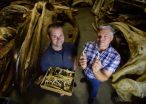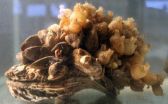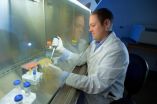(Press-News.org) WINSTON-SALEM, N.C. – Sept. 8, 2014 – Results of a Phase I clinical trial showed that a new drug targeting mitochondrial function in human cancer cells was safe and showed some efficacy. The findings, reported by doctors at Wake Forest Baptist Medical Center, are published in the current online edition of the journal Clinical Cancer Research.
"This drug is selectively taken up by cancer cells and then shuts down the production of energy in the mitochondria," said Timothy Pardee, M.D., Ph.D., director of leukemia translational research at Wake Forest Baptist and principal investigator of the trial. "This is the first drug to inhibit mitochondria in this way and if it proves effective in further clinical trials, it will open up a whole new approach to fighting cancer."
Mitochrondria, which are the powerhouses of the cell, are used differently by healthy cells and cancer cells. Healthy cells use mitochondria as a source of energy to carry out essential functions, whereas leukemia cells use it to reproduce faster and to repair damage from chemotherapy, Pardee said.
In the Phase I trial, 26 patients with relapsed or refractory hematological malignancies were enrolled and given the new drug, CPI-613, as a two-hour infusion on days one and four for three weeks every 28 days. Of the 21 patients who completed the trial, 29 percent saw a benefit from the drug, including one who achieved a complete remission that has lasted more than three years and another who had a partial response that has lasted more than two years.
These data suggest that agents targeting mitochondrial metabolism can be safely administered and have activity in blood-related cancers like leukemia, the researchers reported.
Based on these findings, a Phase II clinical trial is underway at Wake Forest Baptist.
INFORMATION:
Support for the clinical trial was provided by National Cancer Institute grants P30CA012197 and 1K08CA169809, the Doug Coley Foundation for Leukemia Research, the Frances P. Tutwiler Fund, The MacKay Foundation for Cancer Research and Cornerstone Pharmaceuticals, which manufactured and provided CPI-613.
Pardee has received honoraria in the past from Cornerstone Pharmaceuticals, as well as research support.
Co-authors of the study are King Lee, Ph.D., Scott Isom, M.S., Lance D. Miller, Ph.D., Kristin M. Stadelman, M.S., Denise Levitan, M.D., David Hurd, M.D., Leslie R. Ellis, M.D., Robin Harrelson, B.S.N., Megan Manuel, M.S.N., Sarah Dralle, M.S.N., Susan Lyerly, PA-C, and Bayard L. Powell, M.D., of Wake Forest Baptist; and John Luddy, M.S., Claudia Maturo, M.S., and Robert Rodriguez, M.B.A., of Cornerstone Pharmaceuticals Inc.
Novel cancer drug proves safe for leukemia patients
2014-09-08
ELSE PRESS RELEASES FROM THIS DATE:
New genomic editing methods produce better disease models from patient-derived iPSCs
2014-09-08
New Rochelle, NY, September 8, 2014—Highly valuable for modeling human diseases and discovering novel drugs and cell-based therapies, induced pluripotent stem cells (iPSCs) are created by reprogramming an adult cell from a patient to obtain patient-specific stem cells. Due to genetic variation, however, iPSCs may differ from a patient's diseased cells, and researchers are now applying new and emerging genomic editing tools to human disease modeling, as described in a comprehensive Review article published in Stem Cells and Development, a peer-reviewed journal from Mary ...
Living in the shadow of Mauna Loa: A silent summit belies a volcano's forgotten fury
2014-09-08
Alexandria, Va. — Earth's largest active volcano, Mauna Loa on Hawaii's Big Island, is taking a nap. And after 30 years, no one is sure when the sleeping giant will awaken. Scientists say it's likely to erupt again within the next couple of decades and, when it does, it will be spectacular — and potentially dangerous.
Although Mauna Loa often takes a back seat to the more famous Kilauea, which has been erupting nearly continuously since 1983, history warns us that Mauna Loa's current silence is anomalous. Meanwhile, more people and more buildings pack into potentially ...
Whale sex: It's all in the hips
2014-09-08
Both whales and dolphins have pelvic (hip) bones, evolutionary remnants from when their ancestors walked on land more than 40 million years ago. Common wisdom has long held that those bones are simply vestigial, slowly withering away like tailbones on humans.
New research from USC and the Natural History Museum of Los Angeles County (NHM) flies directly in the face of that assumption, finding that not only do those pelvic bones serve a purpose – but their size and possibly shape are influenced by the forces of sexual selection.
"Everyone's always assumed that if you ...
Study puts some mussels into Bay restoration
2014-09-08
Restoring oysters—and their ability to filter large volumes of water—is widely seen as a key way to improve the health of Chesapeake Bay. New research makes this calculus even more appealing, showing that the mussels that typically colonize the nooks and crannies of a restored oyster reef can more than double its overall filtration capacity.
The study—by researchers at the University of Maryland, the Smithsonian Environmental Research Center, and the Virginia Institute of Marine Science—appears as the cover story in the most recent issue of Restoration Ecology.
"Many ...
New targets for treating pulmonary hypertension found
2014-09-08
Two new potential therapeutic targets for the treatment of pulmonary arterial hypertension, a deadly disease marked by high blood pressure in the lungs, have been identified by researchers at the University of Illinois at Chicago. Their findings are reported in the American Journal of Respiratory and Critical Care Medicine.
Early symptoms of pulmonary arterial hypertension include shortness of breath and exercise intolerance. As the disease progresses, patients may require oxygen supplementation and lung transplantation. Heart failure can develop and is a major cause of ...
New compound inhibits enzyme crucial to MERS and SARS viruses, with a catch
2014-09-08
Scientists at the University of Illinois, Chicago, have identified a compound that effectively inhibits an enzyme crucial to the viruses that cause Middle East respiratory syndrome (MERS) and severe acute respiratory syndrome (SARS). The compound appears to have a different method of inhibition in each virus due to slight differences in each virus' enzyme which means finding other compounds that inhibit both may be difficult according to research presented at the 54th Interscience Conference on Antimicrobial Agents and Chemotherapy (ICAAC) an infectious disease meeting ...
How quickly viruses can contaminate buildings and how to stop them
2014-09-08
Using tracer viruses, researchers found that contamination of just a single doorknob or table top results in the spread of viruses throughout office buildings, hotels, and health care facilities. Within 2 to 4 hours, the virus could be detected on 40 to 60 percent of workers and visitors in the facilities and commonly touched objects, according to research presented at the 54th Interscience Conference on Antimicrobial Agents and Chemotherapy (ICAAC), an infectious disease meeting of the American Society for Microbiology.
There is a simple solution, though, says Charles ...
A low-energy optical circuit for a new era of technology
2014-09-08
Unlike electronic circuits, optical, or "photonic", circuits work with light rather than electricity, which makes them 10 to 100 times faster. They are also more energy-efficient because they show lower heat loss, better signal-to-noise ratios and are less susceptible to interference. Used especially for communications (e.g. fiber optics), optical circuits may use tiny optical cavities as 'switches' that can block or allow the flow of light, similarly to transistors in electronics. EPFL scientists have now fabricated and experimentally tested a silicon-based 'photonic crystal ...
To admit or not to admit: Variation in hospitalizations from ER costs billions
2014-09-08
ANN ARBOR, Mich. — It sounds like the setup for a joke: Two identical patients go to two different hospital emergency entrances, complaining of the same symptoms.
But what happens next is no laughing matter, according to a new University of Michigan study published in the September issue of Health Affairs. While one patient may get treated and released from the emergency department, the other gets sent upstairs to a hospital bed – at a cost of tens of thousands of dollars.
In fact, doctors at one hospital may be as much as six times as likely to admit an emergency ...
Scientists reveal cell secret potentially useful for vaccines
2014-09-08
The best defense is a good offense, especially when it comes to the immune system. The troops that respond to an infection are split into two squadrons, and, until recently, it seemed that the two were independent, without much interaction.
Now, in a paper published this week in Nature Immunology, a team of scientists from the Virginia Tech Carilion Research Institute and the University of Alabama at Birmingham say that the immunology boot camp is more communication-intensive than initially thought — a discovery that could help efforts to produce more effective vaccines.
"We ...



